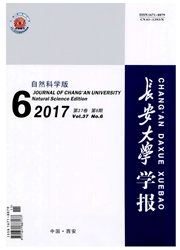

 中文摘要:
中文摘要:
针对单点十字路口绿色交通的控制问题,给出一种考虑路段上公交车和小汽车物理排队的自适应公交优先信号优化设置方法。首先,描述了一个考虑公交车和小汽车相互作用的动态交通模型,该模型能够模拟车辆的物理排队现象,模型假设路段上的流量分为2种状态:一种是公交车和小汽车均为自由流状态,另一种是公交车和小汽车交织在一起的拥挤状态;然后,进一步给出在路段上小汽车和小汽车的延误计算方法,并以此为基础,以人均延误为性能指标计算优化的绿性比;最后,通过仿真方法给出了在低、中、高以及事故情况等几种不同交通拥挤条件下,公交优先信号的优化结果。研究结果表明:在低度拥挤的情况下,考虑公交优先问题并没有实质意义;在中度拥挤的情况下,考虑公交优先的信号配时方案能稍微改善乘客的行驶时间,减少路段排队;在高度拥挤的情况下,优化的绿性比会比固定绿性比好一些;当路口相关路段出现交通事故时,在不同拥挤状态下,优化绿性比能够比固定绿性比获得更多的效益。
 英文摘要:
英文摘要:
Regarding the green traffic control problem at single point intersections, an adaptive bus priority signal control method was presented with consideration of the physical queues of cars and buses on links. Firstly, a dynamic traffic model that could simulate the physical queues of vehicles was described considering the interaction between cars and buses. The flow conditions on link were divided into two classes, one was the un-congested condition, where buses and cars were in flow state; the other was congested condition, where buses and cars were intertwined together. Furthermore, the calculation method of buses and cars delay was proposed, and on this basis, the optimal green ratio was calculated according to average person delay. Finally, the optimized result of bus priority signal was given under several congested conditions. The results show that it is meaningless to consider bus priority under low congested condition. The signal method can improve the passengers' travel time and link queue under mid-congested conditions. The optimal green ratio is better than fixed green ratio under over-congested conditions. Optimal green ratio considering the effects of accidents can obtain more benefits than the fixed green ratio under different congested conditions. 6 tabs, 1 fig, 22 refs.
 同期刊论文项目
同期刊论文项目
 同项目期刊论文
同项目期刊论文
 期刊信息
期刊信息
